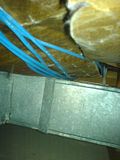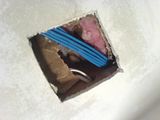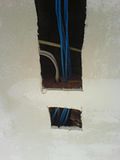I just bought a house and while remodeling decided it would be best to get my cat5e put in. Tonight the guy running the cable finally finished up. My goal is to have gigabit speeds on these lines, thus the cat5e.
In my previous research I often came across the advice to keep the cat5e cable away from power lines (going to the lights/fans/etc) whenever possible, and if you had to cross one, to do it at a 90 degree angle. And the optimal distance from power lines being 3+ feet.
Well turns out my house was a b*tch to wire and they had to get right into bed with some of the electric wires. I have some pictures, and I just wanted advice. Is there any way to shield these lines?
In this picture you can see the Cat5e cables resting on the AC vent. I'm told that the vibrations are mainly what can deteriorate signal, so I plan to pad this and get is far from the vent as possible (probably 4-5 inches).

<>
The remaining pictures show the cat5e being run by power. Obviously there are multiple points of "contact" and i'm concerned as to how it will effect my signal. What can i do to shield the cat5e?

<>

<>

<>

<>

In my previous research I often came across the advice to keep the cat5e cable away from power lines (going to the lights/fans/etc) whenever possible, and if you had to cross one, to do it at a 90 degree angle. And the optimal distance from power lines being 3+ feet.
Well turns out my house was a b*tch to wire and they had to get right into bed with some of the electric wires. I have some pictures, and I just wanted advice. Is there any way to shield these lines?
In this picture you can see the Cat5e cables resting on the AC vent. I'm told that the vibrations are mainly what can deteriorate signal, so I plan to pad this and get is far from the vent as possible (probably 4-5 inches).

<>
The remaining pictures show the cat5e being run by power. Obviously there are multiple points of "contact" and i'm concerned as to how it will effect my signal. What can i do to shield the cat5e?

<>

<>

<>

<>

![[H]ard|Forum](/styles/hardforum/xenforo/logo_dark.png)